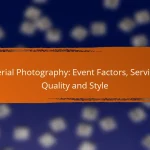What are the regulations for aerial photography in the UK?
Aerial photography in the UK is governed by several regulations that ensure safety, privacy, and data protection. Key considerations include compliance with Civil Aviation Authority (CAA) guidelines, adherence to the Data Protection Act, and obtaining necessary permissions from local councils.
Civil Aviation Authority (CAA) guidelines
The CAA regulates the use of drones for aerial photography in the UK. Operators must obtain a valid Permission for Commercial Operations (PfCO) if they intend to use drones for commercial purposes. Additionally, pilots must adhere to specific operational limitations, such as maintaining visual line of sight and avoiding restricted airspace.
It is crucial to stay updated on any changes to CAA regulations, as they can impact flight operations. For example, new rules may introduce additional training requirements or operational restrictions based on drone weight and capabilities.
Data Protection Act compliance
Under the Data Protection Act, aerial photography must respect individuals’ privacy rights. If your photography captures identifiable people or private property, you may need to obtain consent from those individuals or property owners. This is particularly relevant for commercial projects.
Consider implementing a data protection policy that outlines how you will handle and store any personal data collected during your aerial photography. This can help mitigate risks associated with potential breaches of privacy laws.
Local council permissions
Local councils may require specific permissions for aerial photography, especially in urban areas or near sensitive sites. It is advisable to check with the local authority before conducting any flights to ensure compliance with local regulations.
Some councils may have designated no-fly zones or specific guidelines that must be followed. Engaging with local authorities can also help you understand any community concerns and build goodwill before your project begins.
How to obtain permissions for aerial photography?
To obtain permissions for aerial photography, you need to secure the necessary regulatory approvals and landowner consent. This process typically involves applying for specific permissions from aviation authorities and ensuring you have the rights to fly over private properties.
Applying for a CAA Permission for Aerial Work
In the UK, you must apply for a Permission for Aerial Work from the Civil Aviation Authority (CAA) if you plan to use a drone for commercial purposes. This application requires you to demonstrate your understanding of safety regulations, operational procedures, and risk assessments.
The application process may take several weeks, so it’s advisable to start early. Ensure you provide all required documentation, including proof of pilot competency and details about the equipment you will use.
Securing landowner consent
Before conducting aerial photography over private land, you must obtain consent from the landowner. This is crucial to avoid legal issues and potential disputes. Landowner consent can often be secured through direct communication, explaining the purpose of your aerial work.
It’s wise to have a written agreement outlining the terms of access, including the duration of the shoot and any limitations. This protects both parties and clarifies expectations. If you plan to fly over multiple properties, consider creating a checklist to track which landowners have granted permission.
What are the legal restrictions on drone usage in the UK?
In the UK, drone usage is governed by specific legal restrictions that ensure safety and privacy. Operators must adhere to regulations set by the Civil Aviation Authority (CAA), which include registration requirements and operational limitations based on the drone’s weight and intended use.
Airspace restrictions
Airspace restrictions in the UK dictate where drones can be flown. Drones must not be operated in controlled airspace without permission, which includes areas near airports and military zones. Operators should always check airspace classifications and obtain necessary permissions before flying.
Additionally, drones are generally prohibited from flying above 120 meters (approximately 400 feet) and must maintain a visual line of sight with the operator. Familiarity with local airspace maps and restrictions is crucial for compliance.
Privacy laws
Privacy laws in the UK impact how drones can capture images and videos. The Data Protection Act requires drone operators to respect individuals’ privacy rights, meaning that capturing images of people without consent may lead to legal repercussions. Operators should be aware of the implications of their aerial photography.
Furthermore, the Information Commissioner’s Office (ICO) has guidelines on using drones for data collection. Operators should ensure that any personal data collected is handled in accordance with these regulations, including obtaining consent when necessary.
What are the safety requirements for aerial photography?
The safety requirements for aerial photography primarily involve ensuring the safe operation of drones or aircraft used in capturing images. This includes adhering to local regulations, conducting thorough pre-flight checks, and obtaining appropriate insurance coverage.
Pre-flight safety checks
Before any aerial photography session, it’s crucial to perform comprehensive pre-flight safety checks. This includes inspecting the aircraft or drone for any mechanical issues, verifying battery levels, and ensuring that all systems are functioning properly. A checklist can help ensure that no critical steps are overlooked.
Additionally, assess the weather conditions, as strong winds or inclement weather can pose significant risks. Familiarize yourself with the flight area, noting any obstacles like power lines or buildings that could interfere with the flight path.
Insurance requirements
Insurance is an essential aspect of aerial photography, protecting both the operator and the public in case of accidents. Many jurisdictions require operators to have liability insurance that covers potential damages caused by their aerial activities. This insurance can vary widely in cost, often ranging from a few hundred to several thousand dollars annually, depending on coverage limits and the type of operations.
It’s advisable to consult with an insurance professional who understands the specific needs of aerial photography to ensure adequate coverage. Additionally, some venues or clients may require proof of insurance before granting permission for aerial shoots, making it vital to have this in place before planning any projects.
How to choose the right equipment for compliant aerial photography?
Selecting the right equipment for compliant aerial photography involves understanding both the drone specifications and camera capabilities that meet local regulations. Prioritize drones that are easy to operate and have features that align with legal requirements to ensure safe and effective aerial imaging.
Recommended drone models
When choosing a drone for aerial photography, consider models that are well-regarded for their stability, camera quality, and ease of use. Popular options include the DJI Mavic series and the Autel Robotics EVO series, which offer good flight times and high-resolution cameras.
Ensure the drone you select complies with local regulations, such as weight limits and registration requirements. In the U.S., for example, drones over 0.55 pounds must be registered with the FAA.
Camera specifications for legal compliance
The camera used in aerial photography should have a minimum resolution of 12 megapixels to capture high-quality images. Additionally, consider cameras that offer features like GPS tagging, which can help in meeting regulatory requirements for location tracking.
Check local laws regarding image capture, especially in sensitive areas. Some regions may have restrictions on capturing images of private property without consent, so understanding these regulations is crucial for compliance.
What are the consequences of non-compliance in aerial photography?
Non-compliance in aerial photography can lead to significant legal and financial repercussions. Violating regulations can result in fines, penalties, and potential lawsuits from affected parties.
Fines and penalties
Fines for non-compliance in aerial photography can vary widely depending on the jurisdiction and the severity of the violation. In the United States, for example, fines can range from hundreds to tens of thousands of dollars for serious infractions. It’s crucial to stay informed about local regulations to avoid these costly penalties.
In some cases, repeated violations may lead to increased fines or even the suspension of flying privileges. Operators should regularly review their compliance status to mitigate financial risks.
Legal action from affected parties
Individuals or businesses affected by non-compliance in aerial photography may pursue legal action against the operator. This can include claims for invasion of privacy, property damage, or other grievances. Legal costs can escalate quickly, making it essential to adhere to regulations.
Additionally, operators may face lawsuits that seek damages, which can be substantial depending on the circumstances. To protect against such risks, aerial photographers should obtain appropriate insurance and ensure they follow all relevant laws and guidelines.
What emerging trends are shaping aerial photography regulations?
Emerging trends in aerial photography regulations are primarily driven by advancements in drone technology, increased public interest, and growing concerns about privacy and safety. These factors are prompting regulatory bodies to adapt existing laws and create new frameworks to address the evolving landscape of aerial imaging.
Technological advancements in drone capabilities
As drone technology continues to evolve, regulations are adapting to accommodate features such as enhanced imaging systems, automated flight paths, and real-time data transmission. These advancements allow for more precise and efficient aerial photography but also raise concerns about airspace management and safety. Regulatory bodies are working to establish guidelines that ensure safe operation while promoting innovation.
For instance, drones equipped with advanced sensors can capture high-resolution images and videos, making them invaluable for industries like agriculture, real estate, and environmental monitoring. However, operators must stay informed about the specific regulations governing the use of such technology, which can vary by region.
Increased public awareness and demand for transparency
Public awareness of aerial photography and drone usage has surged, leading to higher expectations for transparency and accountability from operators. Communities are increasingly concerned about privacy issues and the potential for misuse of aerial imagery. In response, regulators are implementing stricter guidelines to protect individual privacy rights while allowing for legitimate aerial photography activities.
Operators should be proactive in communicating their intentions and obtaining necessary permissions when flying in populated areas. This not only fosters goodwill but also helps to navigate the complex regulatory landscape effectively.
Regulatory responses to safety and privacy concerns
Safety and privacy concerns are prompting regulatory agencies to develop comprehensive frameworks that govern aerial photography. These regulations often include restrictions on flight altitude, no-fly zones, and requirements for obtaining permits in sensitive areas. Compliance with these regulations is crucial for operators to avoid penalties and ensure safe operations.
For example, in the United States, the Federal Aviation Administration (FAA) has established guidelines that require drone operators to maintain visual line-of-sight and avoid flying over people without permission. Understanding and adhering to these regulations is essential for anyone involved in aerial photography.






